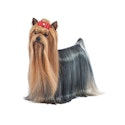Yorkshire Terrier Dog Breed

- Size
- Toy
- Height
- 6 to 9 inches
- Weight
- Up to 7 pounds
- Coat
- Long
- Energy
- High
- Activities
- Agility, Obedience, Rally Obedience, Tracking, Conformation
Easily recognized by a luxurious, floor-length coat, the adaptable Yorkshire Terrier is a loyal and protective companion.
Temperament
Like other toy dog breeds, the Yorkshire Terrier has a big personality. Yorkies are fearless, tenacious and fiercely protective, which makes them perfect little watch dogs.
This toy-sized dog is intelligent and eager to please, but can be stubborn at times. Training and socializing a Yorkshire Terrier puppy should begin at an early age.
Although small in size, Yorkies still need some exercise. A couple short walks a day and occasional games of fetch will help keep them physically and mentally fit.
Characteristics
Yorkies have a long, floor-length coat covering their small, compact bodies. The hair around their eyes is either trimmed short or pulled into a “topknot,” often accented with a bow. The long hair is parted down the middle from the back of the head to the tail. It hangs straight down either side of the body.
Lifespan
11 to 15 years
Colors
The most common colors are a combination of blue and tan or blue and gold. Other colors may include black and gold or black and tan.
Shedding
The Yorkie’s hypoallergenic coat sheds infrequently, but requires daily brushing and weekly baths to keep the hair clean and tangle free.
Health
Yorkshire Terriers are a healthy breed overall. A couple health conditions to watch for include eye problems and a dislocated kneecap known as luxating patella. Limit a Yorkie’s jumping height to help prevent luxating patella.
Yorkies may be prone to weight gain, so they need daily exercise and monitored food and treat intake.
Best Dog Food for Yorkshire Terrier Dogs & Puppies
Yorkshire Terriers need a complete and balanced dog food or puppy food. Because they have smaller mouths, they may prefer a small breed dog food with smaller kibble pieces.
For information on how much or when to feed your Yorkie dog or puppy, explore our feeding articles here.
History
When Scotland weavers migrated to Yorkshire and Lancashire in northern England, they brought their terriers with them.
Over time, they bred a new terrier from several types of now-extinct Scottish terriers, plus the Skye Terrier, Dandie Dinmont Terrier and perhaps even the Maltese.
Yorkies were bred to squeeze into small spaces to root out rodents in the mid-1800s. After the Kennel Club of England recognized the breed in 1886, the Yorkshire Terrier went from a working dog to fashionable ladies’ companion. The breed’s size decreased further as a result of its newfound popularity as a ladies’ lap dog.
The Yorkshire Terrier was first noted in the U.S. in the 1870s. The American Kennel Club (AKC) recorded their first Yorkie in 1885.
Facts
- Developed by Scottish weavers, many joked the Yorkie’s long, flowing coat was the result of the looms where it first worked.
- In addition to the looms, Yorkies also worked in coal mines.
- Although the breed was developed by the Scots, an 1870 reporter commented the name should change to Yorkshire Terrier because the dog was further established and improved there.
- The Yorkie has been a top 10 most popular breed since roughly 2013.